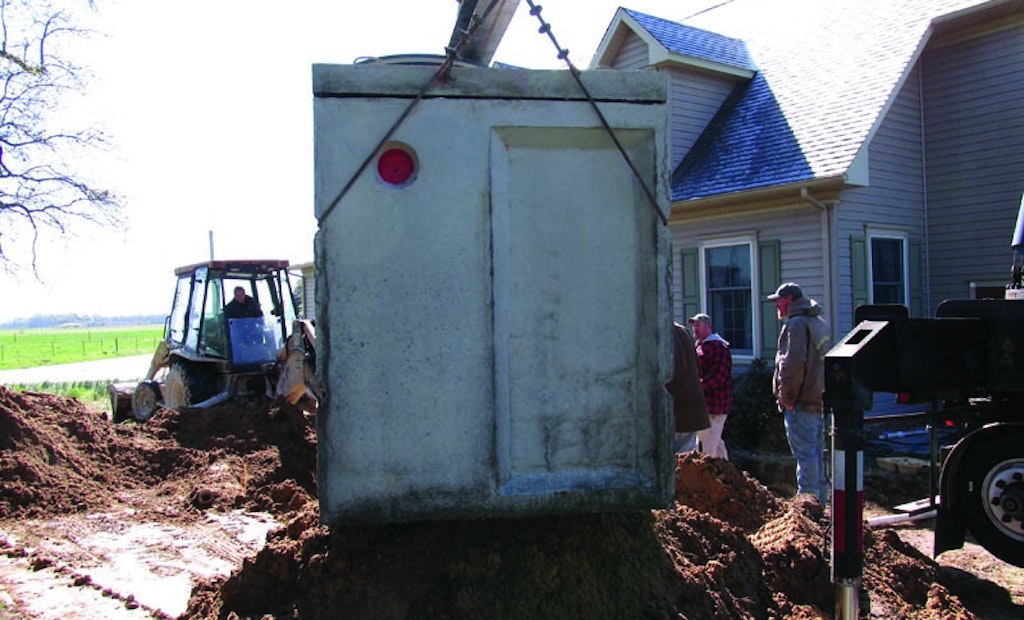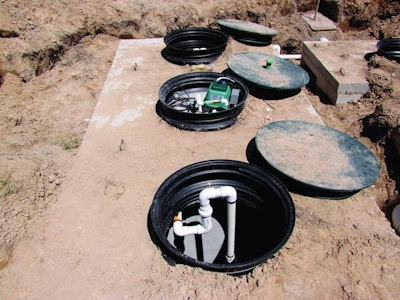
Interested in Systems/ATUs?
Get Systems/ATUs articles, news and videos right in your inbox! Sign up now.
Systems/ATUs + Get AlertsThe first Norweco Hydro-Kinetic wastewater treatment system to be installed in the State of Maryland is right where Bill Towers wants it: close, where he can keep an eye on it. There is more to this than his curiosity. It is a field validation of the system.
Under state rules, Towers says, 12 Hydro-Kinetic systems must be installed in the course of a year, become field certified and accumulate a year’s worth of good test results before installers will be allowed to offer the systems to their customers. So Towers and his people will be taking composite samples four times per year, once each season, and these will be analyzed by a commercial laboratory.
Towers’ company, Towers Concrete Products Inc., is in Denton, Md. It sits on the Delmarva Peninsula that juts into the Atlantic Ocean and forms Chesapeake Bay on its western side. Almost all of Delaware and the eastern part of Maryland fit on this piece of land, plus a little bit of Virginia.
The economy is heavily dependent on agriculture, especially poultry. The headquarters for Perdue, the national chicken producer, is about 45 miles from Denton in Salisbury, Md. From Towers’ office it’s about 45 miles to the Atlantic and about 45 miles to Chesapeake Bay, and his company serves the entire peninsula down to the Virginia border. This puts him right in the middle of the territory affected by new clean-water rules for the bay, and that is what makes his test of the Norweco system so important. If approved by the state, it will give installers another option for the very environmentally sensitive properties in his part of the country.
THE SITUATION
There was nothing wrong with the old system at Towers Concrete. It was a typical 1,500-gallon, two-compartment concrete tank that was installed in 1999 when the present office building was constructed. Next to it was 250 linear feet of standard perforated 4-inch plastic pipe laid over a stone bed. Towers retained that to disperse water from the new Hydro-Kinetic system.
Soils are light and sandy, so there was no question about good drainage. The water table is not a complication at his property. “In the area we service, the water table is an issue on most of this part of the shore,” Towers says. That includes some islands in Chesapeake Bay, and the Hydro-Kinetic equipment should be advantageous in those situations because its effluent is very clean and will help prolong the life of the discharge system, he says.
The Hydro-Kinetic installation is spread across three concrete tanks, manufactured by Towers Concrete. From the office, waste flows through a 4-inch pipe and into a 750-gallon settling and pretreatment tank.
Water then flows into a 1,300-gallon, three-chamber tank. The first chamber is an anoxic section for denitrification and some digestion. Next is an aeration chamber for aerobic digestion of waste. Last is a clarification chamber with a recirculating pump to send a portion of the water back to the anoxic chamber.
From the large tank, water flows into the last stage, a 319-gallon filtration tank. Inside is enclosed growth media. As water fills the tank from the bottom inlet, it submerges the media and bacteria attached to it digest more of the organic material in the water. From this tank an outlet takes water to the drainfield.
Because it was a test and his own project, installation of the Norweco system was put off for months by other work and then by the harsh winter. The job waited until spring.
“We did it in a day,” Towers says. “We put it in the morning of some bad weather. I had a lot of help because we weren’t very busy.”
FLEXIBLE ARRANGEMENT
Norweco components are dropped into the proper compartments. The design at the Towers property didn’t have much room to work. The pretreatment chamber is one tank. The three-chamber arrangement is a second tank and filtration chamber is a third. All are plumbed so they form three sides of a rectangle and fit into slightly more than 160 square feet.
The ability to mix and match tank sizes provided a needed flexibility for Towers’ own project because the space where the system went in, between his office building and the road, is very small. At the moment, concrete tanks are the only option for this system, but flexible tank sizes have many uses in his territory, he says.
“This is a very rural area, and you’ve still got a lot of individual septic systems,” he says. “We often run into space constraints just like the ones at our office. We do a lot of work replacing longtime systems, and most of those are on smaller lots where there isn’t a lot of space to install a system. Many of these are located in the critical Chesapeake Bay watershed.”
Towers likes that the Hydro-Kinetic system will work even through power outages. “It’s not a really complicated mechanical system. It’s primarily a gravity-flow system, and the only mechanical parts are the aerator systems and recirculation pumps. The big thing is, if you lose power they’ll still work as a gravity-flow system. Out here where we are, we occasionally lose power for periods of time,” he says.
Typical Norweco systems Towers installs use aeration only. He sees the combination of suspended and attached bacterial growth in the Hydro-Kinetic system as good for Chesapeake Bay and the installers who serve the people living near it. “I’m anxious to field-test this system and see what it will do,” he says.
MORE INFORMATION
Norweco, Inc. - 800/667-9326 - www.norweco.com









